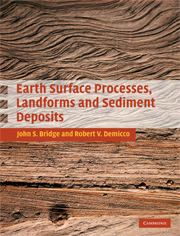Book contents
- Frontmatter
- Contents
- Acknowledgments
- Figure credits
- PART 1 Introduction
- PART 2 Production of sediment at the Earth's surface
- PART 3 Fundamentals of fluid flow, sediment transport, erosion, and deposition
- PART 4 Environments of erosion and deposition
- PART 5 Sediment into rock: diagenesis
- 19 Diagenesis
- PART 6 Long-term, large-scale processes: mountains and sedimentary basins
- References
- Appendix: Methods of study of Earth surface processes, landforms, and sediments
- Index
- Plate section
19 - Diagenesis
from PART 5 - Sediment into rock: diagenesis
Published online by Cambridge University Press: 05 June 2012
- Frontmatter
- Contents
- Acknowledgments
- Figure credits
- PART 1 Introduction
- PART 2 Production of sediment at the Earth's surface
- PART 3 Fundamentals of fluid flow, sediment transport, erosion, and deposition
- PART 4 Environments of erosion and deposition
- PART 5 Sediment into rock: diagenesis
- 19 Diagenesis
- PART 6 Long-term, large-scale processes: mountains and sedimentary basins
- References
- Appendix: Methods of study of Earth surface processes, landforms, and sediments
- Index
- Plate section
Summary
Introduction
Diagenesis is the physical, biochemical, and chemical changes that occur within sediments after deposition, and involves processes such as compaction, cementation, dissolution, and recrystallization (Table 19.1). These processes change the texture, structure, and mineralogy of sediments, and commonly increase the bulk density and reduce the porosity and permeability, thereby transforming the sediments into sedimentary rocks (i.e., lithification). The generation, migration, and entrapment of hydrocarbons happen during diagenesis, and many economic metalliferous deposits (e.g., iron, copper, lead, zinc) that occur in sedimentary rocks owe their origin to diagenesis. Diagenesis occurs as sediments become progressively buried beneath the Earth's surface, and lasts until they are moved into the temperature and pressure range of greenschist-facies metamorphism, or are exposed to another cycle of weathering and erosion. Syn-depositional soft-sediment deformation features such as desiccation cracks, convoluted laminae, and fenestrae are not normally considered to be diagenetic features (Chapter 12), nor are biogenic structures such as burrows, tracks, and trails (Chapter 11).
It is important to understand diagenetic features in sedimentary rocks because (1) they must be distinguished from the primary sedimentary features that are used to interpret the environment of deposition; (2) diagenetic changes in mineralogy must be taken into account in provenance studies (Chapter 3); (3) they provide a record of the burial history of sediments that can be related to factors such as the original depositional environment, the deposition rate, sea-level changes, and tectonic activity; and (4) their influence on porosity and permeability is a major concern to hydrogeologists and petroleum geologists.
- Type
- Chapter
- Information
- Earth Surface Processes, Landforms and Sediment Deposits , pp. 673 - 700Publisher: Cambridge University PressPrint publication year: 2008



